Sold antiquities
Archive of sold antiquities
All artefacts sold in our gallery are fully documented in our online archive and database. Being a specialist ancient art dealer, preserving also the more recent history of each and every piece sold in our shop is at our heart. That is particularly useful for artefacts that changed owners in the meantime. Information that may have been lost in the process can be easily restored from our archives. Please do not hesitate to contact us if you need further information about ancient items that have been sold in our gallery. We can help you with reconstructing the history of ownership for those items. All information about our customers will be kept confidential, of course.-
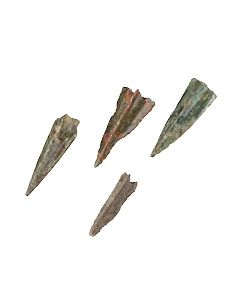 Four Greek or Scythian arrow heads
Four Greek or Scythian arrow headsGroup of four bronze socketed arrowheads, mainly triangular cross-section. Excellent condition, beautiful patina. From an old German collection, acquired in the early 1980s.
Price: on request Roman glass bowl
Roman glass bowlNice bowl made of pale blue green glass. It dates to the late Roman Imperial period. Bought in 1972 at Aloys Faust gallery.
Price: on request Egyptian heart amulet from a museum collection
Egyptian heart amulet from a museum collectionOne of the most popular Egyptian amulet types. From the collection of the Boston Museum of Fine Arts. Late Period of Ancient Egypt.
Price: on request Small Eye of Horus from ptolemaic period
Small Eye of Horus from ptolemaic periodSmall amulet in form of the Eye of Horus. Popular type of protective amulet from Ancient Egypt.
Price: on request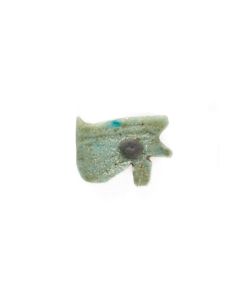 Egyptian Eye of Horus
Egyptian Eye of HorusSmall amulet in form of the Eye of Horus. Popular type of protective amulet from Ancient Egypt.
Price: on request Egyptian Eye of Horus
Egyptian Eye of HorusSmall amulet in form of the Eye of Horus. Popular type of protective amulet from Ancient Egypt.
Price: on request Egyptian terra cotta figurine of Bes
Egyptian terra cotta figurine of BesNice figurine from the Ptolemaic period. It shows the dwarf god with a leonine mask and stuck out tongue.
Price: on request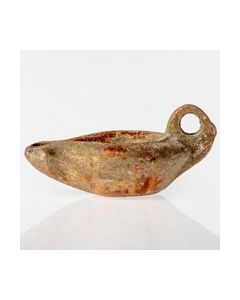 Imperial oil lamp with female bust - rare type
Imperial oil lamp with female bust - rare typeExcellent condition, slip widely preserved, attractive patina. From the collection of Prof. Ritschel, Salzburg, decorated many times, for example in 1995 when the Republic of Austria awarded its Decoration for Science and Art.
Price: on request Hellenistic bronze oil lamp
Hellenistic bronze oil lampPossibly used as votive object or in funerary context. From the collection of Prof. Ritschel, Salzburg, decorated many times, for example in 1995 when the Republic of Austria awarded its Decoration for Science and Art.
Price: on request Rare Roman oil lamp - Ulysses with ram
Rare Roman oil lamp - Ulysses with ramInteresting and very rare mythological scene. From the collection of Prof. Ritschel, Salzburg, decorated many times, for example in 1995 when the Republic of Austria awarded its Decoration for Science and Art.
Price: on request Roman intaglio with Eros child
Roman intaglio with Eros childSlightly oval gemstone made of orange brown glasspaste imitating Carnelian. Dating to Roman times.
Price: on request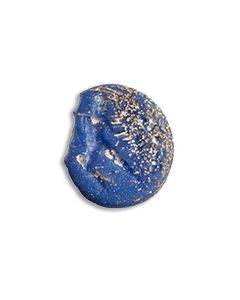 Roman intaglio
Roman intaglioIntaglio made of vibrant blue glass paste. Dates to Roman Republic until Roman Imperial times.
Price: on request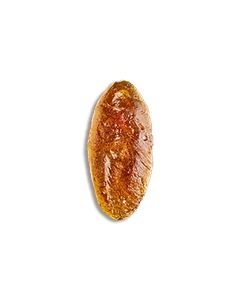 Roman intaglio
Roman intaglioNice orange glowing glass paste imitating carnelian. Gemstone from Roman times.
Price: on request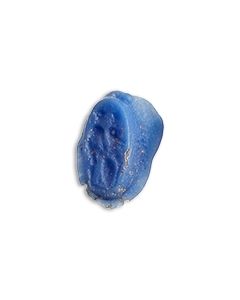 Roman intaglio with two warriors
Roman intaglio with two warriorsExtremely nice sparkling blue glass paste. The scene is similar to a Roman interpretation of the Homeric epics.
Price: on request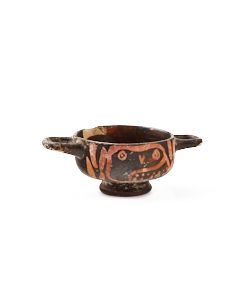 Apulian owl skyphos
Apulian owl skyphosRare Apulian imitation of a popular Athenian type. From an old German collection, acquired 1965 at Hermann Zirkel Gallery in Cologne.
Price: on request Small Athenian lekythos
Small Athenian lekythosNice ancient oil vessel, around 400 B.C. From an old German collection, acquired 1965 at Hermann Zirkel Gallery in Cologne.
Price: on request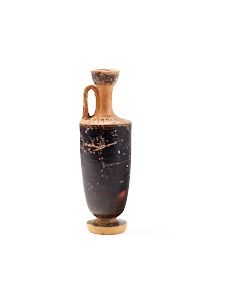 High lekythos found in Athens area
High lekythos found in Athens areaImpressive ancient oil vessel. From an old German collection, acquired in the 1960s at Hermann Zirkel Gallery in Cologne.
Price: on request Etrusco-corinthian alabastron
Etrusco-corinthian alabastronPerfectly preserved, finely worked vessel, reported to have been found in Apulia. From an old German collection, acquired in 1965 at Hermann Zirkel Gallery in Cologne.
Price: on request Late antique oil lamp with round body
Late antique oil lamp with round bodyPossibly from Israel area. Excellent condition. From the collection of Prof. Ritschel, Salzburg, decorated many times, for example in 1995 when the Republic of Austria awarded its Decoration for Science and Art.
Price: on request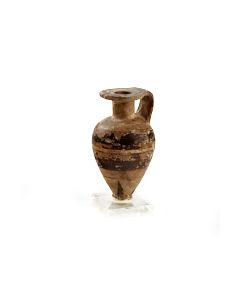 Small proto-corinthian alabastron
Small proto-corinthian alabastronSmall ovoid oil vessel, reported to have been found in Apulia. From an old German collection, acquired in 1965 at Hermann Zirkel Gallery in Cologne.
Price: on request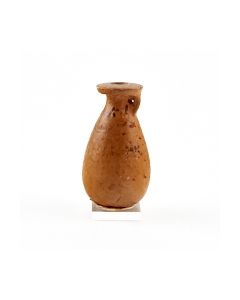 Small Corinthian alabastron
Small Corinthian alabastronTear-drop shaped oil vessel with traces of painting. From an old German collection, acquired in 1965 at Hermann Zirkel Gallery in Cologne.
Price: on request Decorated hellenistic skyphos
Decorated hellenistic skyphosNicely preserved, with dense patina. From the Austrian collection of Prof. Ritschel, carrier of the Large Cross of Honor of the Austrian Republic and many other prizes and honors.
Price: on request Egyptian scarab of lapis lazuli
Egyptian scarab of lapis lazuliFunerary scarab of beautiful blue stone. Late Period of Ancient Egypt. The piece is from the famous Matouk collection.
Price: on request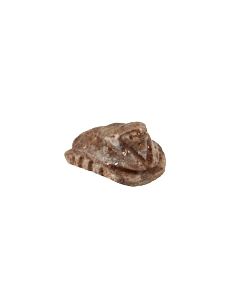 Egyptian scarab with a falcon's head
Egyptian scarab with a falcon's headNaturalistic scarab made of light textured stone. The head of a falcon has been combined with a scarab's body. Late Period of Ancient Egypt.
Price: on request Rare bronze scarab
Rare bronze scarabFrom the Late Period of Ancient Egypt. Dark patinated bronze. The piece is from the famous Matouk collection.
Price: on request Egyptian scarab
Egyptian scarabFunerary scarab of beautiful dark stone. Late Period of Ancient Egypt. The piece is from the famous Matouk collection.
Price: on request Egyptian scarab
Egyptian scarabSmall funerary scarab made of stone. Late Period of Ancient Egypt. The piece is from the famous Matouk collection.
Price: on request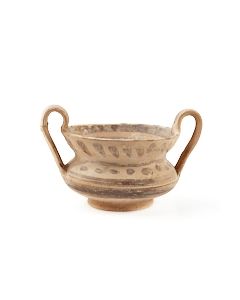 Daunian Kantharos
Daunian KantharosInteresting and unusual drinking cup, reported to have been found in Apulia. Acquired in 1965 at Hermann Zirkel Gallery in Cologne.
Price: on request Rare Egyptian bronze scarab
Rare Egyptian bronze scarabFrom the Late Period of Ancient Egypt. Nicely patinated bronze. The piece is from the famous Matouk collection.
Price: on request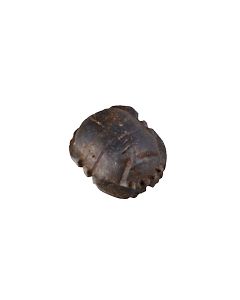 Egyptian scarab
Egyptian scarabFunerary scarab made of dark blue stone. From the greco-roman period of Egypt. A piece from the famous Matouk collection.
Price: on request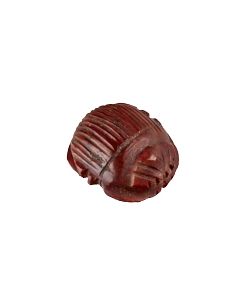 Scarab made of dark red stone
Scarab made of dark red stoneThis fantastic funerary scarab captivates with the beautiful red stone it was made of. A piece from the Greco-Roman period.
Price: on request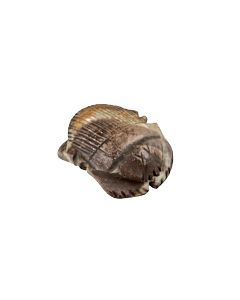 Scarab made of banded stone
Scarab made of banded stoneThis fantastic funerary scarab captivates with the beautiful banded stone it was made of. A piece from the Greco-Roman period.
Price: on request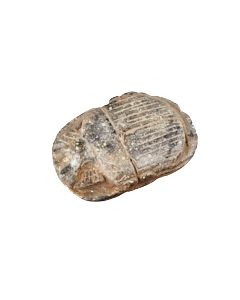 Egyptian scarab
Egyptian scarabFunerary scarab from Ancient Egypt. A nice specimen from the famous Matouk collection.
Price: on request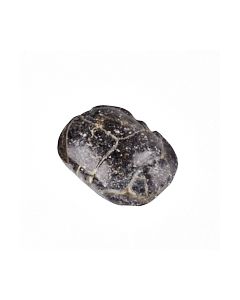 Egyptian scarab
Egyptian scarabFunerary scarab of black stone. Late Period of Ancient Egypt. The piece is from the famous Matouk collection.
Price: on request Hellenistic miniature hydria
Hellenistic miniature hydriaReported to have been found in Central Italy. Perfectly preserved, small vase. Acquired in 1965 at Hermann Zirkel Gallery in Cologne.
Price: on request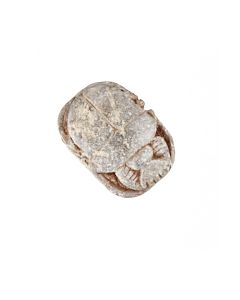 Egyptian scarab
Egyptian scarabFunerary scarab of green and white stone. Late Period of Ancient Egypt. The piece is from the famous Matouk collection.
Price: on request

